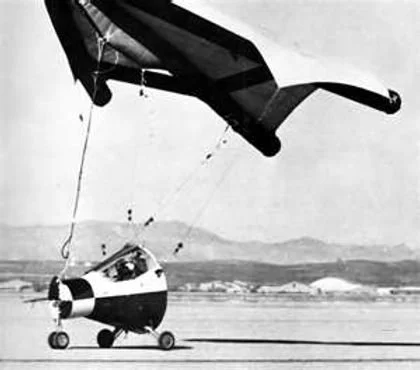NASA hangies in space? pt.2
One project - two schools of thought
A year into initial Parasev tests Milt Thompson had wondered what the pounding footfalls along the corridor outside his office meant one morning. It was aerodynamics expert Dale Reed towing a balsa wood and tissue model he had made at home. It was a true wingless aircraft and flew quite well. This model became the M2-F1, a lightweight lifting body glider initially towed behind a specially-engined Packard muscle car.
After considerable practice getting the feel for this strange aircraft it was then aero-towed to a respectable altitude. So radical was the thought of no-wings-at-all that the in-house enthusiasts had conducted their own project, using a local sailplane builder to make it. With the help of the man who had shaped the plywood panels for Howard Hughes’ Spruce Goose the M2-F1 made its first successful towed liftoff on Apr 5th, 1963, piloted by the CFI. Lift-off speed was 86 mph, but it flew. The initial success of the steel tube frame and elegantly shaped plywood outer surface of this insightful masterpiece should be considered another example of unconstrained American ingenuity.
M2-F1 and C47 tug
Parasev and M2-F1 programmes continued in parallel, involving the same people, until the awkward Parasev was retired in1967. But the basic Rogallo found its destiny as a recreational portable foot-launched device for the people. Vol LIbre was born, and by 1970 the hang-glider idea had spread like wildfire among the thrill-seekers of southern California. In British Airways we used to retire at age 55. I’ve no problem with that, and it allows someone else to have a go. After 12 years of Concordeing I happened to take up modern paragliding in 1998 in Switzerland, and was impressed by the inclusive and matter-of-fact Swiss attitude to this way to fly. The formal school style felt familiar. One morning our teacher showed us ‘Playground in the Sky’, without explanation or introduction. Dating from 1970 the film deals with the chaos and fun of the Rogallo hang-gliding craze that had sprung up at Torrey Pines on the Californian cliffs near San Diego. Big hair, flared jeans, thrills and spills galore. Limited, if any, training in some cases. It captured the opposite approach to the Swiss teaching method - a warning to we sensible learners. Nothing else needs be said, but Playground is unmissable. Find it here.
What was wrong with the NASA Parasev?
Bond and a Ragallo
Nothing, but it was a research vehicle, intended to extend understanding, investigate possibilities, not come up with a finished product. Francis Rogallo’s simple kite device, invented in the 1940s, has proved itself to be a great controllable man-carrier - James Bond chose it for a covert Caribbean intrusion mission in Live and Let Die! But ideas change as time goes by.
After struggling with Parasev testing using experienced astronauts, CFI Milton Thompson got the impression that his select pilots appeared to have special difficulties when trying to manage this parachutal gliding device. He cites serious paragliding accidents elsewhere involving otherwise experienced pilots, and observed that novices seemed to progress better in this field than aircraft pilots. He’s right, and traditional joystick and rudder convention can be a hindrance.
The Rogallo kite, when flown as a simple man-carrying glider, is controlled by weight shift alone. Two axes of control, pitch and roll, are available: it works a treat. All ancillary weight is suspended from the wing aerodynamic centre, and pilot control is achieved via the trapeze-like cross member of a vertical A-frame fixed to a suitable point on the wing centreline tube. Unlike conventional piloting tradition, the pilot now has the complete wing in his or her hands - there are no control surfaces. Push your leading edge up (your weight back) to increase angle of attack becomes obvious the instant you grasp the bar. To turn right you lower your right wing: how to do that? Move your weight to the right via the A frame bar - push this to the left. Rocket science? Not really. It takes just one up and down, one left and right, and I’m sold: minimum handling complications, maximum capacity for tactical thinking.
Modern recreational Rogallo wing development
The picture above is from an article entitled ‘The Paraglider That NASA Could Have Used, but Didn’t, to Bring Astronauts Back to Earth’ written by Billy Vaughn in 2019, on behalf of the Rogallo Foundation and published by the Smithsonian Institute. The Foundation’s centre at Nag’s Head, N. Carolina, is just along the sand dunes from the site of the Wright Brothers’ giant step from gliding to powered flight. This historic coastal area also houses Langley airfield and its NASA presence, not far from the Norfolk Va. Navy Base and Patuxent River Naval aircraft test centre. It was written long after the abandonment of the Parasev project, but reflects the respect in which Francis Rogallo and his wife were regarded by colleagues and supporters.
The first Rogallo-winged Parasev had to be flown by someone sitting in the suspended sit-up seat on a kind of tricycle-undercarriage autogyro rig, equipped with a conventional pilot’s long joystick. How do you get the joystick to influence the wing in the same way? Pulleys and cables etc.. Trim is best accomplished by moving the load support point. Not so easy in flight. Was this possible? Following many tows across the flat lakebed Thompson’s first physically challenging glide after an aero-tow suggested perhaps not. But such was the euphoria at the success of this first Parasev high flight that, against his decision not do it again until the free glide control loads had been investigated, he made a second flight. Nothing had changed and everyone was happy, but he determined not repeat such punishment again.
Parasev control system. Thompson on ramp
Gemini capsule under Rogallo wing with inflatable frame
Research went as far as a Gemini mock-up capsule suspended beneath the Rogallo wing, structurally braced by nitrogen-inflated fabric tubes in this later example. Towed up by a helicopter the pilot released and tried to position for a satisfactory landing on the lakebed. One pilot found that the Rogallo spun violently when released from the tow. He baled out and suffered a broken rib on landing. Another maintained control but met the runway at 1800 fpm. He was also taken to the hospital suffering from shock. The best lander was Jack Swigert, who went on to replace Ken Mattingley in Apollo 13.
In all, 6 Parasevs Mks 1 then 1A,1B etc made 341 flights between 1961 and 1965. For a list of talented, brave, lucky . . test pilots see Wikipedia ‘NASA Paresev’. None exceeded the 65 mph VNE under the Parasev.
Let’s leave it there, with acknowledgment of the remarkable patience and judgment of the CFI. The M2-F1 was looking more promising as experience of it was carefully gained. This lightweight homespun wingless radical glider set the scene for the variety of other metal wingless prototypes. He was always cautious - and right.





